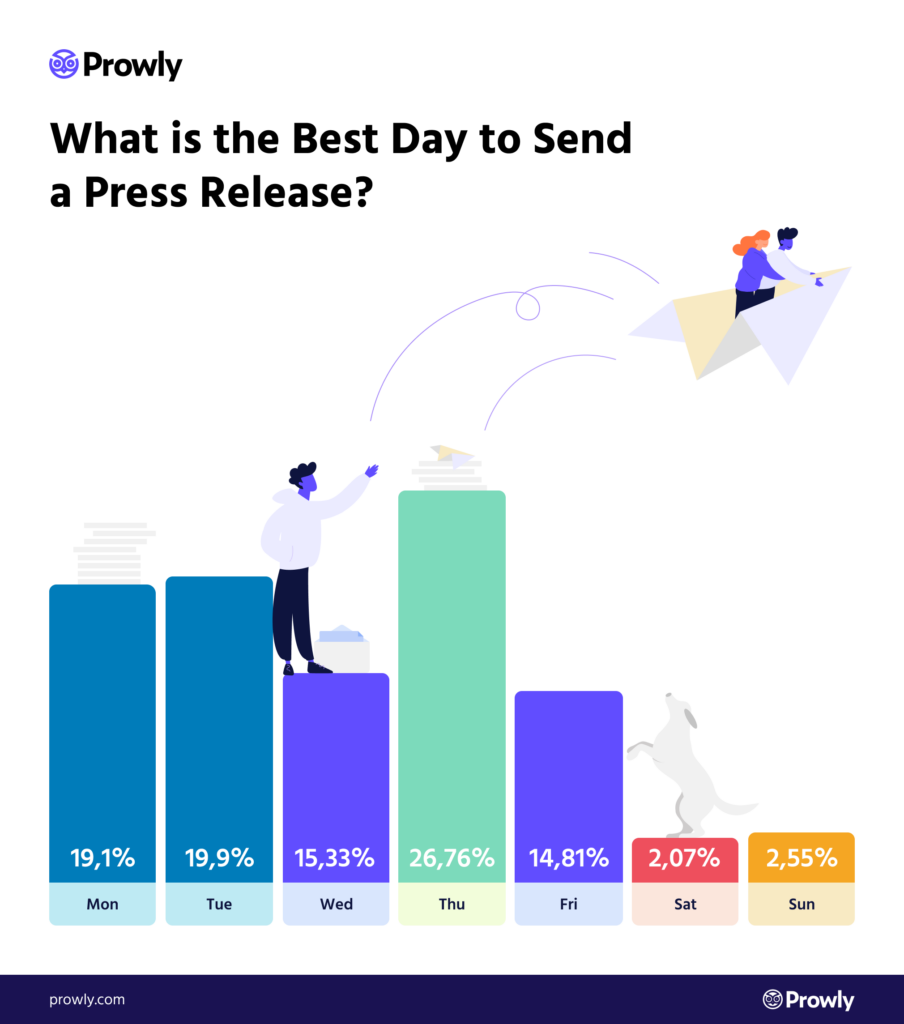We all love numbers, right? What better way to make your point than to back it up with the stats, figures, and data that paint a clearer picture of what you’re talking about?
Using numbers helps your audience to get a better, more precise understanding of the topic at hand. When you say “Most people…”, does that mean 51% or 90%? When you tell your readers that something doubled, did it go from 2 to 4 or from 40 to 80?
There’s a big difference and using the right stats can help your readers come away better-informed thanks to the data that you use.
You might not think that PR lends itself to quantifiable measures but — no offense — you’d be wrong. There are plenty of stats out there that tell us something about the nature of our business, pain points we encounter, what works & what doesn’t, and lots more.
So with that in mind, here are some statistics from the PR industry that can help in a variety of contexts. Whether you’re writing about PR or a specific topic within it, making a presentation on a PR issue, or just have an obsession with numbers (it happens…), here are some statistics that you should know about PR in 2022.
- PR statistics on the state of the industry
- PR statistics on PR skills
- PR statistics on pitching
- PR statistics on the use of technology
- PR statistics on industry trends and predictions
Quick note: All the results below are taken from large sample sizes comprised of a variety of company types, locations, and team sizes.
PR statistics on the state of the industry
The global PR market is worth more than 97 billion US dollars
Back in 2020, the global PR market was worth 88 billion U.S. dollars. By the end of 2025, the industry is expected to surpass a value of 129 billion dollars (Statista, 2022).
Marketing is PR’s best friend within a company
Internal PR teams increasingly work with other departments on company goals. When asked which departments were most likely to be ‘aligned’ with PR in the future (select all that apply), here’s what PR pros said:
| Marketing / Advertising | 60% |
| Internal Communications | 60% |
| Human Resources | 38% |
| Investor Relations | 20% |
| Other | 12% |
Clients will continue hiring PR firms to handle daily communications
PR agency clients will still be hiring PR firms to handle daily interactions with consumers, build brand awareness loyalty, and communicate with stakeholders (IBISWorld, 2021).
PR matters more internally, here’s how
Interesting insights here on PR’s connection to business outcomes. Here are the responses to How can PR increase its value inside your organization? (select all that apply):
| How can PR increase its value inside your organization? | Brand depts | Agencies |
| Getting more coverage & starting more media relationships | 61% | 50% |
| Tying PR activities to key business activities | 57% | 48% |
| Producing measurable results | 50% | 46% |
| Implementing better technology | 19% | 52% |
| Delivering creative solutions | 39% | 45% |
The median annual wage for a PR specialist in the US is $62,800
In May 2022, the median annual wage for a PR specialist in the United States specialist was about 62.8 thousand U.S. dollars (Statista, 2022). Ultimately, the salary depends on the location, specific company, and the experience of the PR specialist.
PR statistics on PR skills
Storytelling is the most important PR skill
While you can’t operate with just one PR skill, some are regarded as more important than others. Here are the responses to What skill sets will be most important in a PR pro moving forward?:
| Storytelling | 72% |
| Social media | 61% |
| Internal Communications | 52% |
| Video | 50% |
| Digital | 58% |
| Writing | 60% |
| Technical skills | 22% |
| Analytics | 50% |
| Other | 8% |
Flexible & creative is the way to go
This is similar to the previous topic, but this time it is more about personal attributes rather than PR skills. Here are the responses to What attributes will be most important in a PR pro moving forward?:
| Flexibility | 75% |
| Entrepreneurial mindset | 38% |
| Ability to work with all departments | 62% |
| Creative thinking | 70% |
| Business acumen | 48% |
| Other | 6% |
PR statistics on pitching
Journalists still want to receive press releases
Some might say that press releases are dead… Yet, 78% of journalists consider press releases, news announcements, and newsworthy stories the kind of content they want to receive from PR professionals (Cision, 2021).
Thursday is the best day to send a press release
Wondering when should you send your press release? The best day to send a press release is on Thursday when the average open rate jumps to over 26%. The worst days, however, are Wednesdays and Fridays when even 85% of your emails can get lost in the journalists’ inboxes.

The best time to send a press release is between 10 am and 2 pm
This is when editors open about one-third of all the emails they’ve received. Early mornings are less effective: open rates drop to 20.5% between 6 and 10 am.
The most important component of a pitch is its relevance
The two answers seem to be variations of the same idea, leaving everything else far behind. Here are the responses to Which of the following components do you believe is most important in a pitch?:
| A topic relevant to the journalist | 42% |
| Content personalized to the journalist | 35% |
| Timeliness | 14% |
| Catchy subject line | 4% |
| Short in length | 3% |
| Including graphic elements or video | 1% |
| Statistics in headline | 1% |
Journalists receive hundreds of (irrelevant) pitches
More than 1 in 4 journalists (28%) receive over 100 pitches per week - and most of these pitches are reported to be irrelevant (Cision, 2021). Pitches that sound like marketing brochures, lack transparency, or are followed by numerous follow-ups - quickly land in the virtual trash.
Journalists respond to just 3% of pitches
Do you often get responses from your media contacts? If so, you might not believe that journalists respond to roughly 3.27% of all pitches they receive (Propel, 2021). Given that most of the email pitches are irrelevant, it shouldn’t come as a big surprise.
PR statistics on the use of technology
Technology will be key in driving industry growth
59% of PR professionals believe that technology will be key in driving the transformation of the PR industry (USC Center for Public Relations, 2019). No wonder. Over the last few years, it’s become clear how much value PR automation can give to PR professionals. Just consider the potential daily, weekly, and monthly time savings alone.
PR professionals are using the tools of the trade
PR pros turn to various tools for help in getting the word out and following what’s being said about their brands and clients. Most agency PR pros use a media database (57%) and media monitoring software (51%) daily.
Interestingly, 49% of surveyed PR pros do not use PR reporting software to measure and analyze the impact of their campaigns and earned media efforts (Muck Rack, 2021).
PR agencies benefit from media monitoring, data analytics, and CRM software
PR professionals favor media monitoring tools that make it easier to track brand mentions and show tangible results to clients. At the same time, PR CRM software has become increasingly important when it comes to managing relationships with clients, media contacts, and influencers (IBISWorld, 2021).
Social media tools are not that popular among PR professionals
Does everyone in PR use social media as much as everyone else? Here are the responses to How often do you use tools to manage or monitor social media?:
| Never | 38% |
| Daily | 33% |
| Weekly | 17% |
| Monthly | 10% |
| Yearly | 2% |
PR statistics on industry trends and predictions
Media relations management doesn’t get easier
60% of PR professionals say media relations is harder or much harder compared to last year – while about one-third (35%) say it’s about the same (JOTW Communications Survey, 2021).
The biggest challenge in PR is getting responses from journalists
What are the top PR challenges professionals in the industry face? No prizes for guessing the top answer. Here are the responses to Which of the following challenges does your PR/communications team face? (select all that apply):
| Getting responses from journalists | 59% |
| Budget limits | 49% |
| Measuring business impact | 46% |
| Lack of quantifiable measurement | 37% |
| Discovering relevant journalists | 34% |
| Collaborating with other departments | 18% |
What’s the future of PR?
Industries evolve and PR is no exception. Here are the responses to Where do you see the focus of the PR profession in the next 2-3 years? (select all that apply):
| Business strategy | 43% |
| Purpose-driven initiatives | 51% |
| Digital-only | 10% |
| Artificial Intelligence | 7% |
| Integration with Internal Communications | 25% |
| Reputation management | 43% |
| Crisis management | 40% |
| Change management | 32% |
| Technology proficiency | 18% |
PR predictions for 2022
Some of these predictions may have been on your radar already while others might come as a surprise. Here are 6 trends that are going to define the conversation about PR in 2022 (Prowly, 2021):
- Moving closer towards content regulation on social media
- A greater emphasis on social responsibility & business ethics
- The rise of Artificial Intelligence and data science
- Digital events are the new norm
- Soon, everyone will have a podcast
- Paid exposure is likely to replace earned media
